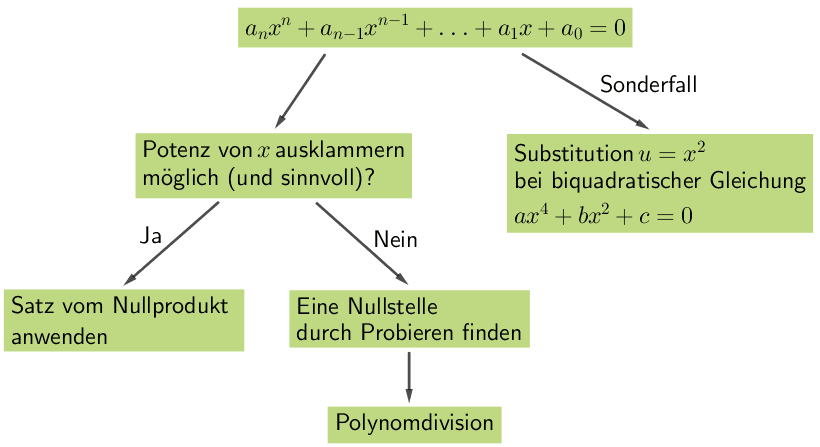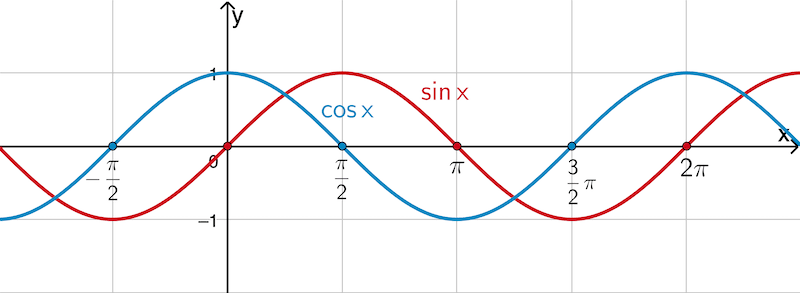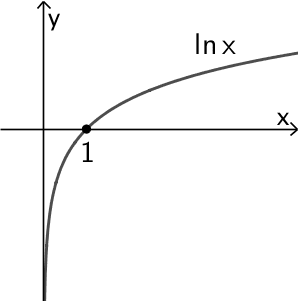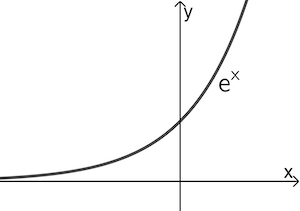Begründen Sie: Wenn \(a = 0\) und \(b \neq 0\) gilt, dann ist der Graph von \(f_{a,b,c}\) symmetrisch bezüglich der \(y\)-Achse und schneidet die \(x\)-Achse nicht.
(2 BE)
Lösung zu Teilaufgabe 2b
\[f_{a,b,c}(x) = \frac{ax + b}{x^{2} + c}; \; a,b,c \in \mathbb R\]
Für \(a = 0\) ergibt sich die Funktion \(f_{0,b,c}\) zu:
\[f_{0,b,c}(x) = \frac{b}{x^{2} + c}\]
Begründung, weshalb der Graph von \(f_{0,b,c}\) symmetrisch bezüglich der \(y\)-Achse ist
Symmetrieverhalten von Funktionsgraphen bzgl. des Koordinatensystems
\(f(-x) = f(x) \hspace{32px} \Longrightarrow \quad G_f\) ist achsensymmetrisch zur \(y\)-Achse
\(f(-x) = -f(x) \hspace{20px} \Longrightarrow \quad G_f\) ist punktsymmetrisch zum Ursprung
\[f_{0.b.c}(\textcolor{#e9b509}{-x}) = \frac{b}{(\textcolor{#e9b509}{-x})^{2} + c} = \frac{b}{x^{2} + c} = f_{0,b,c}(x)\]
\(\Rightarrow \enspace\) Der Graph von \(f_{0,b,c}\) ist symmetrisch bezüglich der \(y\)-Achse.
Begründung, weshalb der Graph von \(f_{0,b,c}\) für \(b \neq 0\) die \(x\)-Achse nicht schneidet
Nullstelle(n) einer Funktion bestimmen
Eine Nullstelle ist die \(x\)-Koordinate eines gemeinsamen Punktes des Graphen einer Funktion \(x \mapsto f(x)\) mit der \(x\)-Achse. An einer Nullstelle gilt: \(f(x) = 0\).

Satz vom Nullprodukt: Ein Produkt ist genau dann null, wenn einer der Faktoren null ist.
\(f(x) \cdot g(x) = 0 \enspace \Rightarrow \enspace f(x) = 0\) oder \(g(x) = 0\)
Ein Quotient von Funktionen ist genau dann null, wenn die Zählerfunktion null ist.
\(\dfrac{f(x)}{g(x)} = 0 \enspace \Rightarrow \enspace f(x) = 0\; (g(x) \neq 0)\)
Lösungsformel für quadratische Gleichungen (Mitternachtsformel, vgl. Merkhilfe)
\[\textcolor{#cc071e}{a}x^2 + \textcolor{#0087c1}{b}x + \textcolor{#e9b509}{c} = 0 \enspace \Leftrightarrow \enspace x_{1,2} = \frac{-\textcolor{#0087c1}{b} \pm \sqrt{\textcolor{#0087c1}{b}^2 - 4\textcolor{#cc071e}{a}\textcolor{#e9b509}{c}}}{2\textcolor{#cc071e}{a}}\]
Diskriminante \(D = b^2 -4ac \;\):
\(D < 0\,\): keine Lösung
\(D = 0\,\): genau eine Lösung
\(D > 0\,\): zwei verschiedene Lösungen
Folgende Fälle lassen sich einfacher durch Umformung lösen:
\[\begin{align*}\textcolor{#cc071e}{a}x^2 + \textcolor{#0087c1}{b}x &= 0 &&| \; x\; \text{ausklammern (Produkt formulieren)} \\[0.8em] x \cdot (ax + b) &= 0 \\[0.8em] \Rightarrow \enspace x = 0 \vee ax + b &= 0 \end{align*}\]
\[\begin{align*}\textcolor{#cc071e}{a}x^2 + \textcolor{#e9b509}{c} &= 0 &&| -c \enspace (c \neq 0) \\[0.8em] ax^2 &= -c &&| : a \\[0.8em] x^2 &= -\frac{c}{a} &&| \; \sqrt{\quad} \\[0.8em] x_{1,2} &= \pm \sqrt{-\frac{c}{a}} \end{align*}\]
Zwei Lösungen, falls \(-\dfrac{c}{a} > 0\), keine Lösung, falls \(-\dfrac{c}{a} < 0\)
Vorgehensweise für die Bestimmung der Nullstelle(n) einer ganzrationalen Funktion ab Grad 3:

vgl. Abiturskript - 1.1.3 Ganzrationale Funktion, Nullstellen
Nullstellen einer gebrochenrationalen Funktion \(f(x) = \dfrac{\textcolor{#0087c1}{z(x)}}{n(x)}\) sind alle Nullstellen des Zählerpolynoms \(\textcolor{#0087c1}{z(x)}\), die nicht zugleich Nullstellen des Nennerpolynoms \(\boldsymbol{n(x)}\) sind.
Ist \(x_0\) eine Nullstelle des Zählerpolynoms \(\boldsymbol{z(x)}\) und zugleich eine vollständig kürzbare Nullstelle des Nennerpolynoms \(\boldsymbol{n(x)}\), so besitzt die gebrochenrationale Funktion \(f\) an der Stelle \(x_0\) eine hebbare Definitionslücke.
(vgl. Abiturskript - 1.2.1 Gebrochenrationale Funktion, Nullstellen und Polstellen)
Eine Wurzelfunktion \(f(x) = \sqrt{\textcolor{#cc071e}{g(x)}}\) nimmt genau dann den Wert null an, wenn der Radikand (Term unter der Wurzel) null ist.
\[\sin{x} = 0 \enspace \Rightarrow \enspace x = k \cdot \pi \; (k \in \mathbb Z)\]
\[\cos{x} = 0 \enspace \Rightarrow \enspace x = \dfrac{\pi}{2} + k \cdot \pi \; (k \in \mathbb Z)\]


Die natürliche Logarithmusfunktion \(x \mapsto \ln{x}\) besitzt die einzige Nullstelle \(\boldsymbol{x = 1}\).
\[\ln{\left( \textcolor{#0087c1}{f(x)} \right)} = 0 \enspace \Rightarrow \enspace \textcolor{#0087c1}{f(x) = 1}\]

Die natürliche Exponentialfunktion \(x \mapsto e^x\) sowie jede verkettete Funktion \(x \mapsto e^{f(x)}\) besitzt keine Nullstelle!
\[\textcolor{#0087c1}{b \neq 0} \enspace \Rightarrow \enspace f_{0,\textcolor{#0087c1}{b},c}(x) = \frac{\textcolor{#0087c1}{b}}{x^{2} + c} \textcolor{#0087c1}{\neq 0}\]
Da der Zähler von \(f_{0,\textcolor{#0087c1}{b},c}(x) = \dfrac{\textcolor{#0087c1}{b}}{x^{2} + c}\) für \(\textcolor{#0087c1}{b \neq 0}\) nicht null werden kann, hat \(f_{0,\textcolor{#0087c1}{b},c}\) für alle \(x \in D_{0,\textcolor{#0087c1}{b},c}\) keine Nullstelle. Folglich schneidet der Graph von \(f_{0,\textcolor{#0087c1}{b},c}\) die \(x\)-Achse nicht.

